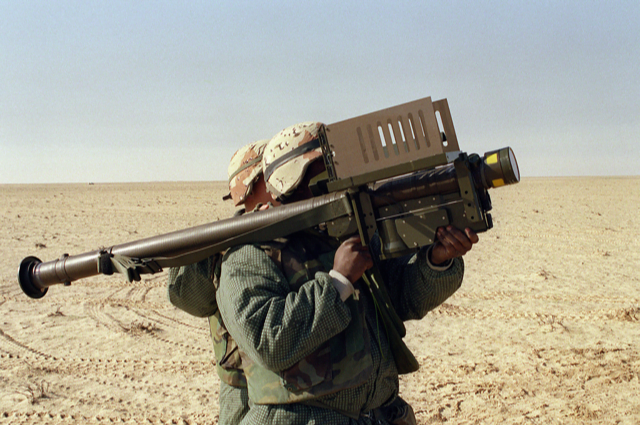UPSC Articles
SECURITY/ INTERNATIONAL
- GS-2: International Relations
- GS-3: Security
Man-Portable Air-Defence Systems (MANPADS)
Context: On March 13, United States President Joe Biden approved a $200-million arms package for Ukraine, which would include U.S. made Stinger Missiles, which are a type of shoulder-fired Man-Portable Air-Defence Systems (MANPADS).
- More than 17,000 anti-tank weapons and 2,000 Stinger missiles have already been sent by the U.S. and NATO in the first week of March itself.

What are MANPADS?
- Man-Portable Air-Defence Systems are short-range, lightweight and portable surface-to-air missiles that can be fired by individuals or small groups to destroy aircraft or helicopters.
- They help shield troops from aerial attacks and are most effective in targeting low-flying aircrafts.
- MANPATs or Man-Portable Anti-Tank Systems work in a similar manner but are used to destroy or incapacitate military tanks.
- MANPADS can be shoulder-fired, launched from atop a ground-vehicle, fired from a tripod or stand, and from a helicopter or boat.
- Weighing anywhere between 10 to 20 kilograms and not being longer than 1.8 metres, they are fairly lightweight as compared to other elaborate weapon systems, making them easy to operate by individual soldiers.
- Operating MANPADS requires substantially less training.
- MANPADS have a maximum range of 8 kilometres and can engage targets at altitudes of 4.5 km.
- Most MANPADS have passive or ‘fire and forget’ guidance systems, meaning that the operator is not required to guide the missile to its target, enabling them to run and relocate immediately after firing.
- The missile stays locked-on to the targeted object, not requiring active guidance from the soldier.
- The missiles are fitted with infrared (IR) seekers that identify and target the airborne vehicle through heat radiation being emitted by the latter.
When were MANPADS used in the past?
- The first MANPADS were introduced by the United States and Soviet Union in the 1960s. Russian and U.S. MANPADS were also used during the Vietnam war.
- The U.S. supplied MANPADS to the Mujahideen in Afghanistan in the 1980s, which the latter used against the Soviet forces.
- Countries such as India, Pakistan, Germany, U.K., Turkey and Israel have also used MANPADS in their defence efforts.
- As of 2019, 20 countries had developed the wherewithal to manufacture MANPADS and have together made 1 million such systems for defence and export purposes.
- Over time, non-state actors such as rebel and terrorist groups have also illicitly acquired MANPADS, using them during civil wars and other high-intensity conflicts.
- MANPADs have been used in the Syrian war and in Libya. Non-state groups in African countries like Sudan, South Sudan, Angola, Somalia and Congo have also acquired and used MANPADs.
- Russia is by far the biggest exporter of MANPADs, having sold over 10,000 such systems between 2010 and 2018 to various countries including Iraq, Qatar, Kazakhstan, Venezuela, and Libya.
What are the common variants of MANPADs?
- The most common make of MANPADs is the U.S.-made Stinger missiles. These weigh about 15 kg, have a range of 4,800 metres or 4.8 km, and can engage low-flying aircrafts at an altitude of 3,800 metres. They have a passive guidance system, which uses infrared technology.
- Stinger’s Russian or Soviet-made counterparts are the Igla MANPADS, which also employ infrared technology. They were used in Iraq when it was invaded by the U.S. in 2003. They have also been used by India, for instance, as part of Operation Trishul Shakti of 1992, during the Siachen conflict.
- Starstreak, the British army’s equivalent of the Stinger missiles and U.K. is formulating a plan to provide Ukraine with a shipment of Starstreaks.
- Sweden makes the RBS-70 MANPADS series while China’s version, FN-6, is akin to the Stinger.
How effective are MANPADs in the Ukraine crisis?
- Ukraine still has some of Soviet era longer-range air-defence systems that can target Russian aircraft, which is why Russia is flying them at low altitudes, which in turn makes them more vulnerable to short-range systems like MANPADS.
- Reports show that at least 20 Russian aircraft — both helicopters and jets — being downed in Ukraine since the current conflict started. Ukraine’s Ministry of Defence, meanwhile, has said that it has shot down 48 Russian planes and 80 helicopters.
- Kyiv-based National Institute for Strategic Studies, an institute advising the Ukraine’s president Volodymyr Zelenskiy on security issues, said that anti-tank and anti-aircraft systems are “precisely” what Ukraine needs right now.
What are the concerns around MANPADS?
- Many observers have pointed out that sending MANPADS to Ukraine may have its share of not so positive effects. The U.S. has also mentioned the ‘risks’ involved in sending such weapons to Ukraine.
- Ukraine is believed to have one of the largest arms trafficking markets in Europe.
- After the annexation of Crimea by Russia in 2014, weapons supplied by other countries to aid Ukraine ended up in the wrong hands in multiple cases.
- Reports indicate that weapons in the state arsenal were illicitly acquired and smuggled by criminal and non-state rebel groups.
- Meanwhile, the Small Arms Survey of 2017 pointed out that Ukraine has 1.2 million legal firearms and around 4 million illegal weapons, a lot of them fully-automatic military weapons.
- Thus, observers fear that sending lightweight ground-based MANPADS to Ukraine may contribute to intensifying the network of illegal weapon trade.
- In other conflict-hit states as well, there is widespread evidence of MANPADS ending up with non-state and terrorist groups; the most prominent cases being Syria, Libya and Afghanistan.
- Another concern around MANPADS is civilian attacks. As per studies, more than 60 civilian aircraft have been hit by MANPADS since the 1970s, claiming the lives of more than 1,000 civilians.
Connecting the dots:














